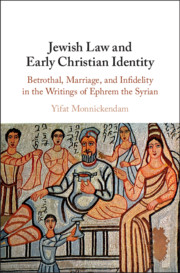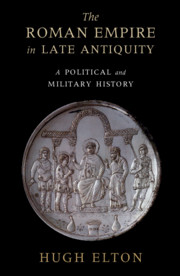Refine search
Actions for selected content:
23990 results in Ancient history
Acknowledgments
-
- Book:
- Jewish Law and Early Christian Identity
- Published online:
- 12 December 2019
- Print publication:
- 09 January 2020, pp ix-xii
-
- Chapter
- Export citation
Chapter 2 - During Betrothal
-
- Book:
- Jewish Law and Early Christian Identity
- Published online:
- 12 December 2019
- Print publication:
- 09 January 2020, pp 87-108
-
- Chapter
- Export citation
Index Locorum
-
- Book:
- Jewish Law and Early Christian Identity
- Published online:
- 12 December 2019
- Print publication:
- 09 January 2020, pp 307-321
-
- Chapter
- Export citation
Dedication
-
- Book:
- Jewish Law and Early Christian Identity
- Published online:
- 12 December 2019
- Print publication:
- 09 January 2020, pp v-vi
-
- Chapter
- Export citation
Chapter 4 - Breaking a Marital Bond
-
- Book:
- Jewish Law and Early Christian Identity
- Published online:
- 12 December 2019
- Print publication:
- 09 January 2020, pp 153-201
-
- Chapter
- Export citation
Contents
-
- Book:
- Jewish Law and Early Christian Identity
- Published online:
- 12 December 2019
- Print publication:
- 09 January 2020, pp vii-viii
-
- Chapter
- Export citation
Index
-
- Book:
- Jewish Law and Early Christian Identity
- Published online:
- 12 December 2019
- Print publication:
- 09 January 2020, pp 322-332
-
- Chapter
- Export citation
Chapter 5 - Discussion and Conclusions
-
- Book:
- Jewish Law and Early Christian Identity
- Published online:
- 12 December 2019
- Print publication:
- 09 January 2020, pp 202-218
-
- Chapter
- Export citation

The Sanctuary at Bath in the Roman Empire
-
- Published online:
- 07 January 2020
- Print publication:
- 16 January 2020

Jewish Law and Early Christian Identity
- Betrothal, Marriage, and Infidelity in the Writings of Ephrem the Syrian
-
- Published online:
- 12 December 2019
- Print publication:
- 09 January 2020

The Roman Empire in Late Antiquity
- A Political and Military History
-
- Published online:
- 29 October 2019
- Print publication:
- 22 November 2018

Realities and Fantasies of German Female Leadership
- From Maria Antonia of Saxony to Angela Merkel
-
- Published by:
- Boydell & Brewer
- Published online:
- 24 October 2019
- Print publication:
- 01 August 2019

The Films of John Schlesinger
-
- Published by:
- Anthem Press
- Published online:
- 04 October 2019
- Print publication:
- 24 August 2019

Class and Power in Roman Palestine
- The Socioeconomic Setting of Judaism and Christian Origins
-
- Published online:
- 03 October 2019
- Print publication:
- 03 October 2019
Bibliography
-
- Book:
- Class and Power in Roman Palestine
- Published online:
- 03 October 2019
- Print publication:
- 03 October 2019, pp 261-332
-
- Chapter
- Export citation
Appendix C - Palamyra Duties (137 ce)
-
- Book:
- Class and Power in Roman Palestine
- Published online:
- 03 October 2019
- Print publication:
- 03 October 2019, pp 259-260
-
- Chapter
- Export citation
Introduction
-
- Book:
- Class and Power in Roman Palestine
- Published online:
- 03 October 2019
- Print publication:
- 03 October 2019, pp 1-15
-
- Chapter
- Export citation
Acknowledgments
-
- Book:
- Class and Power in Roman Palestine
- Published online:
- 03 October 2019
- Print publication:
- 03 October 2019, pp xi-xiv
-
- Chapter
- Export citation
CHAPTER 2 - Land Tenancy and Agricultural Labor
-
- Book:
- Class and Power in Roman Palestine
- Published online:
- 03 October 2019
- Print publication:
- 03 October 2019, pp 71-110
-
- Chapter
- Export citation
Conclusion
-
- Book:
- Class and Power in Roman Palestine
- Published online:
- 03 October 2019
- Print publication:
- 03 October 2019, pp 249-254
-
- Chapter
- Export citation
